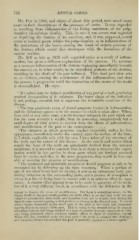Page 722 - My FlipBook
P. 722
732 DENTAL CARIES.
Mr. Fox in LS06, and others of about this period, were much more
exact in their descriptions of the processes of caries. It was regarded
as resulting from inflammation of the lining membrane of the pulp-
chamber (membrana eboris). This, in case it was severe, was regarded
as depriving the dentine of its nutrition, and, it was sujiposed, would
occur at isolated points within the pulp-chamber, as in inflammation of
the periosteum of the bones, causing the death of certain portions of
the dentine, Avhich would then decompose with the formation of the
carious cavities.
Mr. Bell as late as 1829 still regarded caries as a result of inflam-
mation, but gives a different explanation of the process. He assumes
as a cause an inflammation of the dentine beginning immediately beneath
the enamel, or, in other words, in the superficial portions of the dentine,
resulting in the death of the part inflamed. This dead part then acts
as an irritant, causing the continuance of the inflammation, and thus
the process is progressive until the destruction of the crown of the tooth
is accomplished. He says :
" It (caries) may be defined, mortification of amj jmrt of a tooth, producing
gradual decomposition of its substance. The latter clause of the definition
is not, perhaps, essential, but it expresses the invariable condition of the
disease.
" The true proximate cause of dental gangrene (caries) is inflammation,
and the following appears to be the manner in which it takes place: When,
from, cold or any other cause, a tooth becomes inflamed, the part which suf-
fers the most severely is unable, from its possessing comparatively but a
small degree of vital power, to recover from the efiects of inflammation,
and mortification of the part is the consequence
" The situation in which gangrene (caries) invariably makes its first
appearance, immediately under the enamel, upon the surface of the bone,
is, I think, ex])]icaljle only with the view I have taken of the structure of
the teeth and tlie nature of this disease. As the vessels and nerves which
supply the bone of the teeth are principally derived from the internal
membrane, it is natural to conclude that in so dense a structure the organ-
ization would be less perfect in those parts which are fiirthest removed
from its source, and that, in the same proportion, they would be less cap-
able of resisting the progress of mortification
"The continued and invariable progress of dental gangrene is only to be
accounted for by following up the same reasoning. When a portion of
any of the other bones loses its vitality, it acts as an extraneous body, pro-
ducing irritation in the surrounding parts, and a process of absorption is
set up in a line of living bone in contact with it in order to effect its sepa-
ration. A similar effort ap])ears to me to be made in gangrene of the teeth,
but with a very diffei'ent result, in accordance with the difference in the
appear to deserve the name of mortification. But there is something more; for tlie
simple death of the part would produce but little etiect, as we find that teeth are not
subject to jiutrefaction after death, and therefore I am apt to suspect that during life
there is some operation going on that produces a change in the diseased part. It almost
always begins externally in the small part of the body of the tooth, and commonly
appears first as an opa
sion being destroyed, which i)roduces similar effects to those of powdered crystal.
When this has crinnbled away, the bony part of the tooth is exposed (the dentine);
and when the disease has attacked this part, it generally appears as a brown speck."


